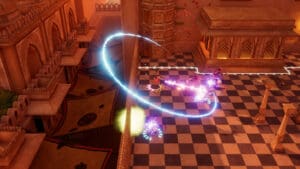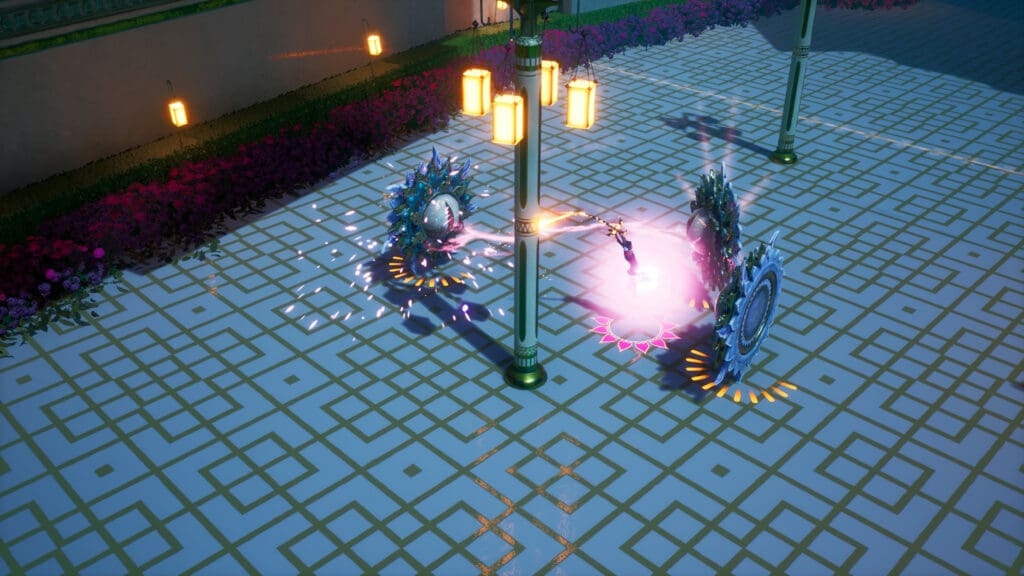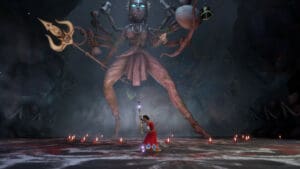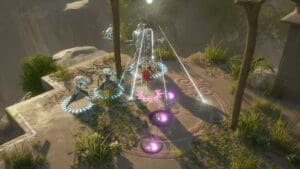Video games have the capacity to tell a story, but not just any story; they have the capacity to tell the tale of histories and people that no one has ever seen or heard of. Most games trend to the tried-and-true, with whimsical takes of elves and trolls, coupled with adrenaline-filled adventures in a cyberpunk dystopia. Video games have told the tales of planets at war, hedgehogs against mad-scientists, and plumbers plundering a psychedelic mushroom kingdom; there comes a time where a change of scenery is needed. Video games have evolved to tell many new stories. Raji: An Ancient Epic is just an example of one new story.
When I first played Raji: An Ancient Epic, it was at a small meetup in Seattle, at an event tied to PAX WEST, called The Mix. In-between the crowds of people and flowing beer was a hidden gem. It was familiar, but unlike anything I have played before, with its focus on Hindu mythology and lore. An encounter with Raji would occur once again at PAX EAST in March of 2020, where more of the game was shown. Once again, Raiji was bursting with confidence in itself and enthusiasm for the story it sought to tell.
An Ancient Epic
Raji: An Ancient Epic tells the tale of Raji, a young woman accompanying her brother, Golu. A terrible storm brews and terrifying forces of evil abduct Golu, bringing him into another realm. Overwhelmed by darkness, Raiji falls but reawakens into a parrel world, where she is destined to rescue her brother. However, no mortal has done this before. The Goddess Draga and the God Vishnu grant her the tools and weapons needed to fight the heinous beings that took her brother, but it is all useless if she does not bring it upon herself to fight. Draga and Vishnu watch from above and pray for the mortal as she embarks on a journey between good and evil.
Raji: An Ancient Epic is an isometric action-adventure game, where players enter grand environments and fight various enemies along a fairly linear path. As Raiji, players run, jump, and leap through environments, while at moments, fight supernatural enemies. Players gain access to divine weapons to fight demons, and enemy bosses. In each level, certain spots allow players to heal or gather more power for their weapons, including recharging their special attack.
Incredibly Fascinating Break From Norms
Raiji: An Ancient Epic is a refreshing breakthrough in visual storytelling and artistic interpretations. Most games in this genre trend towards Greek or Japanese mythology. Raiji: An Ancient Epic is a breathtaking and incredibly fascinating break from norms. The story or Raji An Ancient Tale is told through animated cutscenes resembling ancient puppetry, depicting the story through animated illustrations, all to a cultural soundtrack that is attuned to sitars and drums. During each level, there are illustrations of mythological stories, tales of divine beings, and the mortal that have interacted with the world beyond their own.
Raji An Ancient Tale presents these moments as optional to the overall story. Each level has several, and players can interact and listen to the narration. These quick moments are nice breaks to the overall story, and invite players to learn more about the cultural stories of Hinduism. Most importantly, these moments are not distractions but reminders that Raji An Ancient Tale is a more authentic and heartfelt story in the universe of Hinduism as opposed to bending the rules of Greek mythology as seen in God of War. Raiji: An Ancient Epic goes out of its way to give players the feeling of embarking on a tale of myth and lore, and it leaves a satisfying feeling throughout.
Intricately Done Albeit A Bit Lifeless
The environments to Raiji: An Ancient Epic are vast and intricately well done, albeit a bit lifeless. Players explore wide, large temples filled with grand statues and emblazoned in color. Each level leaves a mark on players, from the water temple of Vishnu to the floating mythical cities of the afterlife. Gold shrines and reflects on towering spires and grand hallways glow with orange. It’s a memorable, mesmerizing experience, and all the while, a sitar heightens the mood. Calming sensations are felt during moments of platforming and puzzle-solving. During moments of combat, the sitar soundtrack heightens and becomes more frantic. It’s an interesting choice, as most action-based games usher in grand orchestra and electronic guitars.
One of the nice touches regarding storytelling is the narration from Hindu Gods following Raji. They ponder, discuss, and debate Raji’s progress as her journey becomes darker and more dangerous. This approach gives the experience another perspective and gives the players the sensation of observing a legendary tale, as well as providing meaning and context to Raji’s journey. This perspective distinguishes Raiji An Ancient Epic from other titles in the genre and brings
Balance Between Exploration And Combat
Combat in Raiji An Ancient Epic is an isometric hack’n’slash, featuring a variety of close, medium, and long-range weapons. Those familiar with other action games will find themselves familiar with the combat system in Raiji An Ancient Epic. Players attack, evade, parry, and occasionally deploy a special power to attack. There is a sense of weight and appropriate delay to the attack system to give the sensation of wielding a heavy, but divine weapon, capable of smiting demonic foes. It isn’t something instant and snappy, such as Musou titles, but that adjustment is appropriate here. Raiji is a mortal woman embarking on a mission not destined for mortals. It’s through her sheer will she is able to wield such weapons, but she is not weak.
Dispatching foes is enjoyable, and using the necessary skills is easy to understand, as well as easy to employ. A large spear works to eliminate large demons. If enough damage is done to a demon, a button-press initiates an instant kill upon the demon. Smaller enemies are more difficult to eliminate with the large weapons, but Raiji: An Ancient Epic equips players to a special bow and arrow later in the game. This weapon also has unique properties that make it effective to use in combat. Using and learning these weapons is essential to survive, and the enemies are not pushovers. This is most especially established during the game’s several boss fights, which are easier than expected, but nonetheless imaginative in design and scope.
Between the bouts of combat, there is exploration and puzzle-solving. Raji jumps, leaps, and explores large temples and fortresses that are wonderfully realized in depth and scope. Players use Raiji for puzzle solving as well. At times, players align a painting on the floor to unlock the path, all the while hearing the narrative of the Hindu Gods. Raiji An Ancient Epic finds a balance between exploration and combat but leans more on exploration.
The only real fault for Raiji: An Ancient Epic lies in its length and replayability. Raiji An Ancient Epic last a good while at close to ten hours or more for finding secrets and replaying the game on a higher difficulty setting. However, there is no Director’s Cut and once the game is over, players will have seen everything that Raiji: An Ancient Epic. More enemies and boss fights would have been a nice addition, and different variations in the gameplay would have broken the repetition. Despite these small blemishes, Raiji: An Ancient Epic still provides an excellent and distinct adventure worth embarking on.
 Closing Thoughts
Closing Thoughts
Games like Raiji An Ancient Epic are important for today’s gaming arena as it tells a story from a part of the world not often seen in games. Raiji: An Ancient Epic bolsters the story through a remarkable infusion of gameplay and visuals. While the experience is rather short, this is a great breakthrough for Nodding Head Games and designer Avichal Singh and I sincerely hope that Raiji: An Ancient Epic spearheads more games from India to be released worldwide. From its stellar cultural presentation to solid gameplay, Raiji: An Ancient Epic is an epic journey worth embarking on.
Raji: An Ancient Epic was reviewed on the Nintendo Switch thanks to a key generously supplied to Marooner’s Rock by UberStrategist









